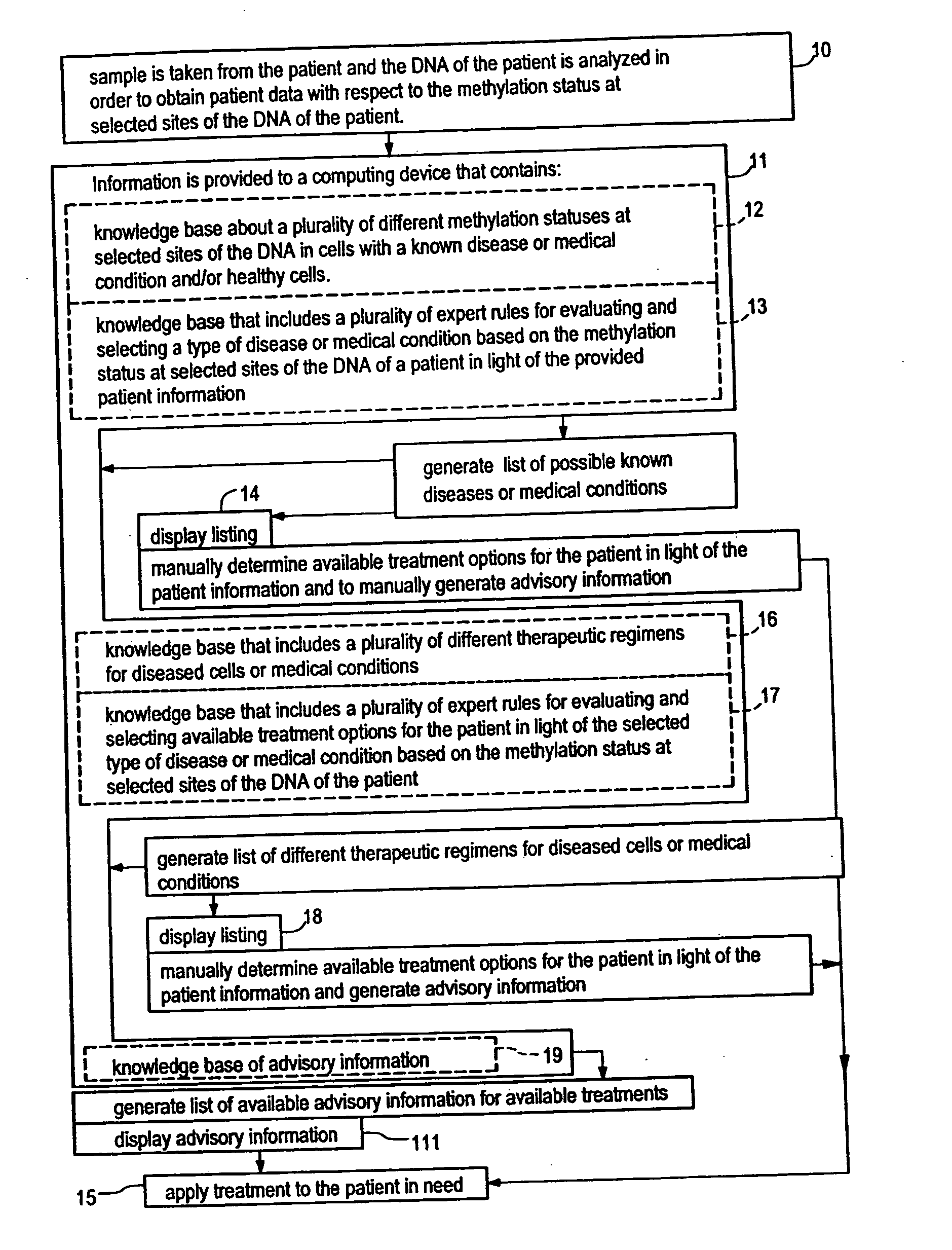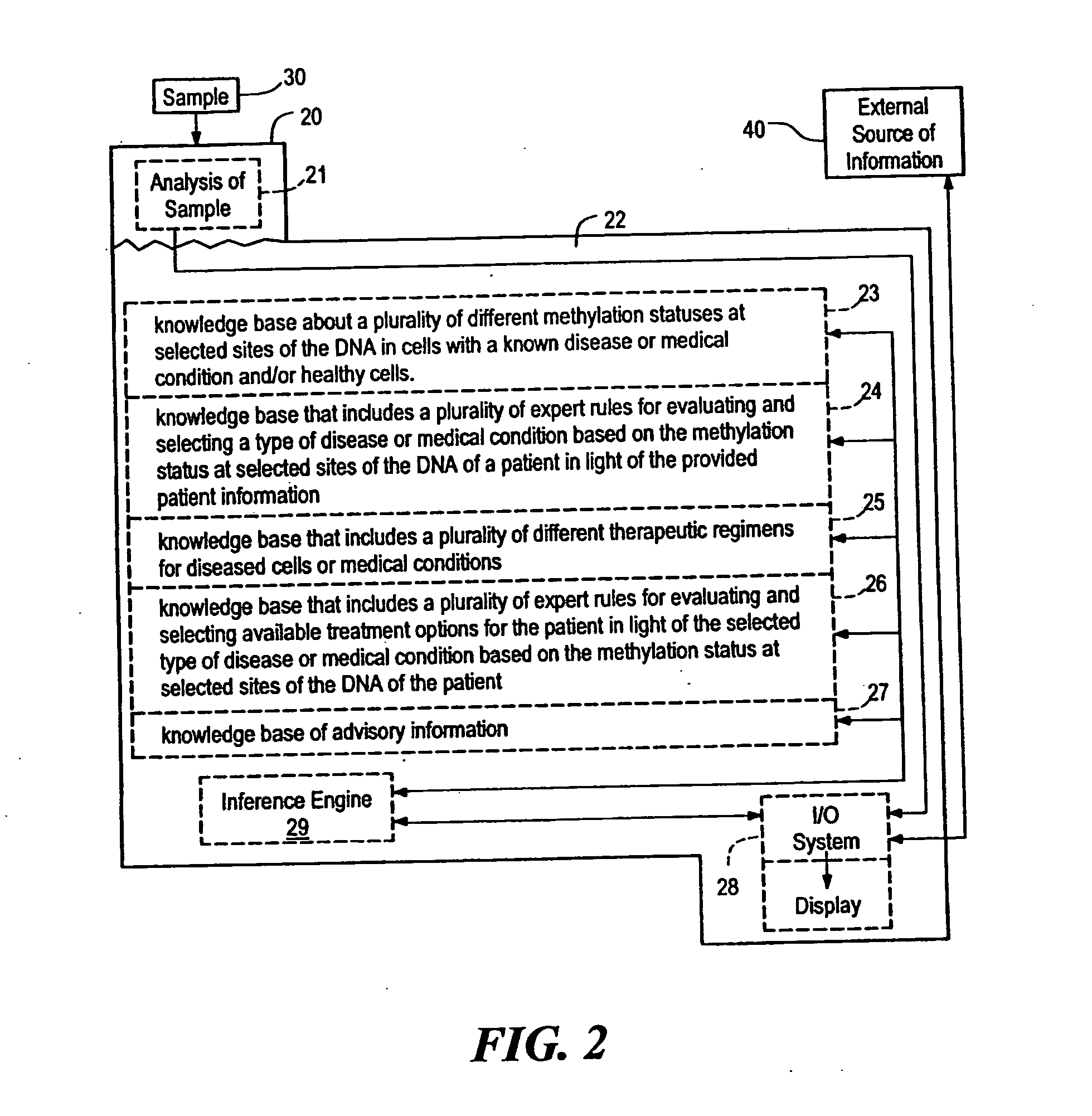Systems, methods and computer program products for guiding selection of a therapeutic treatment regimen based on the methylation status of the DNA
a technology of methylation status and computer program products, applied in the field of systems, methods and computer program products for guiding the selection of therapeutic treatment regimens for complex disorders, can solve the problems of failure to detect proteins of regulatory importance from small amounts of cells, high validation rate of methods, and inferiority to modern gene expression based on rna analysis in two regards
- Summary
- Abstract
- Description
- Claims
- Application Information
AI Technical Summary
Benefits of technology
Problems solved by technology
Method used
Image
Examples
example 1
Example: Diagnosis and Treatment of Patient with a Colon Cell Proliferative Disorder
For the initial build-up of the database system for use in the method of the present invention, a first knowledge base is generated by collecting information regarding the methylation status of selected sites of a DNA, wherein said methylation status is correlated with certain diseases or medical conditions. Furthermore, comparative data is added that reflects the methylation status of the same selected sites in a sample taken from a healthy individual. The initial connective data between the methylation statuses and the respective diseases (and / or specific subtypes of diseases, such as different forms of colon cell proliferative disorders or other cancerous diseases) is generated by connecting a specific disease type that has been diagnosed based on physiological diagnostic factors of the patient (such as the histological analysis of tissues or the analysis of blood cells) and characterised by th...
example 2
Method Employing Treatment Regimen in Order to Treat an Acute Outbreak of a Disease
A tissue sample from a patient suffering from a completely unknown or insufficiently specified acute disease is taken in the practice of a medical doctor or from medical personnel in a hospital. In the context of the present invention, the term “insufficiently specified acute disease” designates a generally diagnosed disease like, for example, cancer without specifying the exact type of cancer the patient is affected with. Further examples would be an acute viral infection or a generally specified bacterial infection. The sample of the patient contains DNA from the cells of the patient to be examined. Basically all types of samples that contain DNA from the patient can be employed in the method of the present invention. The sample can contain either specific tissue, like single types of blood cells, single types of liver cells or cells of a single tumour, or unspecific tissue, like skin, brain or o...
example 3
Example Employing a Preventive Treatment Regimen
A tissue sample from a healthy person or a person suffering from a yet unidentified or non-acute infection or other disease like cancer in a very early stage is taken in the practice of the responsible medical doctor or from other personal in a hospital. The sample contains DNA from the patient to be examined. Therefore, the sample can contain either specific tissue, like single types of blood cells, single types of liver cells or cells of a single tumour, or unspecific tissue, like skin, brain or other organs. The sample is then shipped together with additional patient information to a central laboratory in order to analyse the methylation statuses at selected sites of the patients' DNA. Optionally, the sample can be analysed for its methylation statuses at selected sites of the patients' DNA in an analytical device as described above, having two components as described above, which is either located in the practice of the medical ...
PUM
| Property | Measurement | Unit |
|---|---|---|
| Weight | aaaaa | aaaaa |
| Therapeutic | aaaaa | aaaaa |
| Drug dose (mass) | aaaaa | aaaaa |
Abstract
Description
Claims
Application Information
 Login to View More
Login to View More - R&D
- Intellectual Property
- Life Sciences
- Materials
- Tech Scout
- Unparalleled Data Quality
- Higher Quality Content
- 60% Fewer Hallucinations
Browse by: Latest US Patents, China's latest patents, Technical Efficacy Thesaurus, Application Domain, Technology Topic, Popular Technical Reports.
© 2025 PatSnap. All rights reserved.Legal|Privacy policy|Modern Slavery Act Transparency Statement|Sitemap|About US| Contact US: help@patsnap.com



